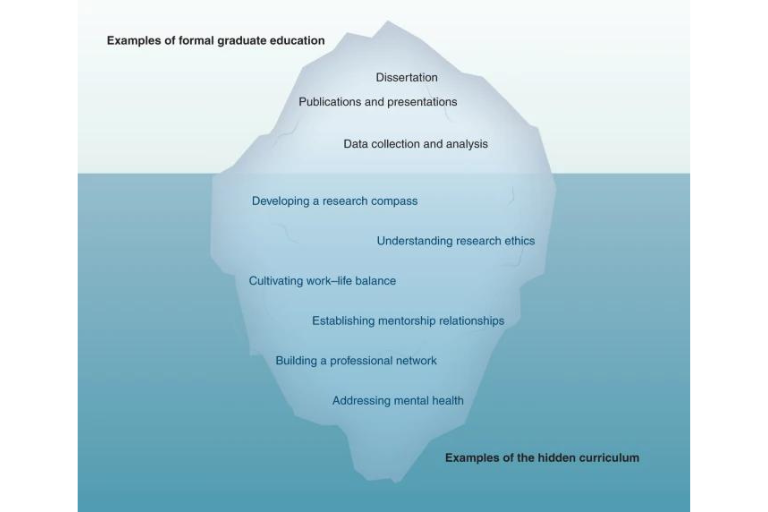As we are approaching the stressful time that the end of the semester can be, we’d like to highlight some aspects of social class that are often invisible and under-addressed to support the diverse students in the classroom. Higher education has been valorized as a way to equalize opportunities for people of all different classes of backgrounds, but does it? We take time to unpack how classism manifests itself within higher education and how we can do better for our students, peers, and beyond when it comes to social class equity. This week, we will explore how class can be perpetuated in the form of a hidden curriculum. This curriculum operates as a series of unspoken rules and expectations that influence one’s success in higher education — ranging from the reasons for attending college to strategies for navigating university resources. 1, 2 Thus, effective advocates and allies in higher education develop practices that make the hidden curriculum explicit to all students. This week, we will specifically use some examples from graduate programs and how to create an equitable graduate learning environment.

Hidden Curriculum – Financing Graduate Programs
Financing graduate programs is one of the areas that is largely unaddressed. Graduate students often are surprised when they receive their first bursar bill and, for the first time, realize the full implications of their funding package— especially when some expenses, like fees, are not covered. Very often, the details of financing graduate programs are not explicitly addressed during admissions by the graduate office, program, or faculty members. However, the hidden curriculum of financing graduate programs implies “you are supposed to know this. If you aren’t, that’s a shame.” This sense of shame caused by not knowing the hidden curriculum is a common phenomenon, although its influence varies by field.3 When the information on financing graduate studies is implicit, the impact is disproportionately negative for graduate students and even faculty with lower socioeconomic (SES) backgrounds. For example, the precarity of tuition remission and the stipend system pose greater threats for students from the lower SES backgrounds, which in turn affects well-being.4 Faculty with lower SES backgrounds want to support these students but often fear they perpetuate a “bootstraps” narrative, since their position as role models might implicitly legitimize the “hidden curriculum.”5 The effects of this hidden curriculum are compounded by barriers for other marginalized communities. Undergraduate women with lower SES backgrounds, for instance, report a greater sense of social alienation than peers with higher SES backgrounds.6 The intersections of racism, sexism, and classism translate to microaggressions and stereotypes that place the burdens on Black graduate student women to prove their place.7
Making the Hidden Curriculum Explicit
Pensky and colleagues used an iceberg image to visualize the hidden curriculum of graduate studies. Using the figure below, you can assess how often you have explicitly discussed the topics that are hidden in the water. Students may not have asked you about those topics because they don’t know if it’s “appropriate” to talk about. Thus, it is important for you, as faculty or staff, to mention each aspect and communicate expectations with your students or share relevant resources with them. We should keep in mind, too, that toward the end of the semester, when things are most stressful, financial burdens can also affect the well-being and performance of graduate students who generally live on modest stipends.
A good example of tackling the hidden curriculum of graduate programs is the video, “The Hidden Curriculum of Applying to Graduate School: Funding Opportunities,” posted by the Graduate School of Education, University at Buffalo. In this video, graduate program costs are broken down for international and domestic students, and they even include additional costs for conferences and licensures, and so on. It also goes over ways to finance graduate studies, ways to find funding packages at the school, and details about what the packages cover and do not cover. Furthermore, the video offers examples of student personal finance scenarios. The impact of this video is invaluable. It has made the financing of graduate studies no longer a part of the hidden curriculum, explicitly sharing ways to navigate the financial aspects of graduate programs.

Weekly Resources
- Article: I was a Low-Income College Student. Classes Weren’t the Hard Part. – A must-read article by Dr. Anthony Abraham Jack, professor at the Harvard Graduate School of Education. He talks about how colleges, particularly the elite colleges, fail to make the hidden curriculum of college explicit, including the financial aspects.
- Book: A Field Guide to Grad School: Uncovering the Hidden Curriculum – Indiana University’s very own Dr. Jessica Calarco wrote this book to help prospective and current graduates navigate the complexities of graduate school’s hidden curriculum (and can help faculty understand some of the questions students might have throughout the graduate school experiences.)
- Resources: Student Care and Resource Center and Student Emergency Fund – Direct students to the Student Care and Resource Center when you are not in a position to discuss details of the challenges that students are facing. You may also want to share the emergency funding information for those full-time students who are going through unexpected financial burdens.

